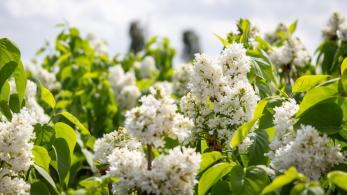Gleditsia Triancanthos - Honey Locust
1. Add items to basket
2. Go to the basket
3. Enter your postcode in Delivery Price Check
Plant shape: Full standard
Trunk height: 1.6-1.8 m
Trunk girth: 8-10 cm
Rootball - supplied without a pot
Plant ID: 4169 100
View plant size:Plant shape: Full standard
Trunk height: 1.8 m
Trunk girth: 10-12 cm
Rootball - supplied without a pot
Plant ID: 3714 100
View plant size:Plant shape: Full standard
Trunk height: 1.8 m
Trunk girth: 12-14 cm
Rootball - supplied without a pot
Plant ID: 3715 100
Plant shape: Single Stem
Trunk height: 1.8-2 m
Trunk girth: 14-16 cm
Rootball - supplied without a pot
Plant ID: 3713 80
To check delivery cost add your plants to basket, then you can type your postcode in our Quick Delivery Price Check.
The Honey Locust Tree, botanically known as Gleditsia Triancanthos, is a deciduous large tree with plenty of colourful elegant character. It suits mid-sized spaces and gardeners who enjoy bright foliage on their flowering trees.
The Honey Locust Tree is native to North America, from South Dakota to Massachusetts, but has settled well in the UK. It is the parent tree of the popular Honey Locust Sunburst. Gleditsia Triancanthos is fast growing and produces bright green almost yellow pinnate leaves in spring that bring a fresh, clean aspect to the garden. These feathery leaves face one another in pairs on the branch with a final leaf pointed at the tip. They turn a golden yellow in autumn and fall en-masse when the frosts arrive. Fragrant, cream-coloured blooms appear in late spring, bursting from the leaf base to attract many pollinators. These transform into long, flat and textured seed pods that resemble fingers in early autumn. The seed pods of Gleditsia Triancanthos are an earthy brown and measure 15-20 cm in length. They are unusual in the UK and attract attention from passers-by. In winter the frothy foliage and seeds pods fall to reveal a strong framework of grey plated bark.
How Hardy Is Gleditsia Triancanthos
Its feathery foliage and lengthy seeds pods belie an extremely tough tree that withstands all nature can throw at it. The Honey Locust Tree can survive sub-zero temperatures, temporary floods, pollution and coastal conditions.
How To Use Gleditsia Triancanthos
It is perfect for urban planting as it tolerates heavy pollution, and when used as a boundary tree against a road it will help block out fumes. It also tolerates salty, breezy conditions making it ideal for coastal gardens.
The light shade it casts means you are able to under plant with a variety of woodland choices, including bluebells, primroses, perennials and ferns. Its strong framework also makes a good back drop for red and yellow dogwoods in the winter. Gleditsia Triancanthos is an attractive yet sensible choice for new urban developments as it will withstand poor soil conditions that are compacted and dry.
How To Care For Gleditsia Triancanthos
This mid-sized deciduous tree needs little care once established, but as with all trees it will need regular water and food as it lays down its roots. Pruning is not required and you will not need to shape or thin out the branches. We provide this tree as a multi-stemmed variety as it adds naturalistic texture and interest, and enables the tree to grow quickly into a manageable screen. You can shape this tree should you wish to by simply removing unwanted branches in winter when the tree is dormant.
The Honey Locust Tree is a great choice for someone that needs quick growing greenery. It is delicate-looking yet sturdy and perfect for busy people who enjoy watching a tree change throughout the seasons.













